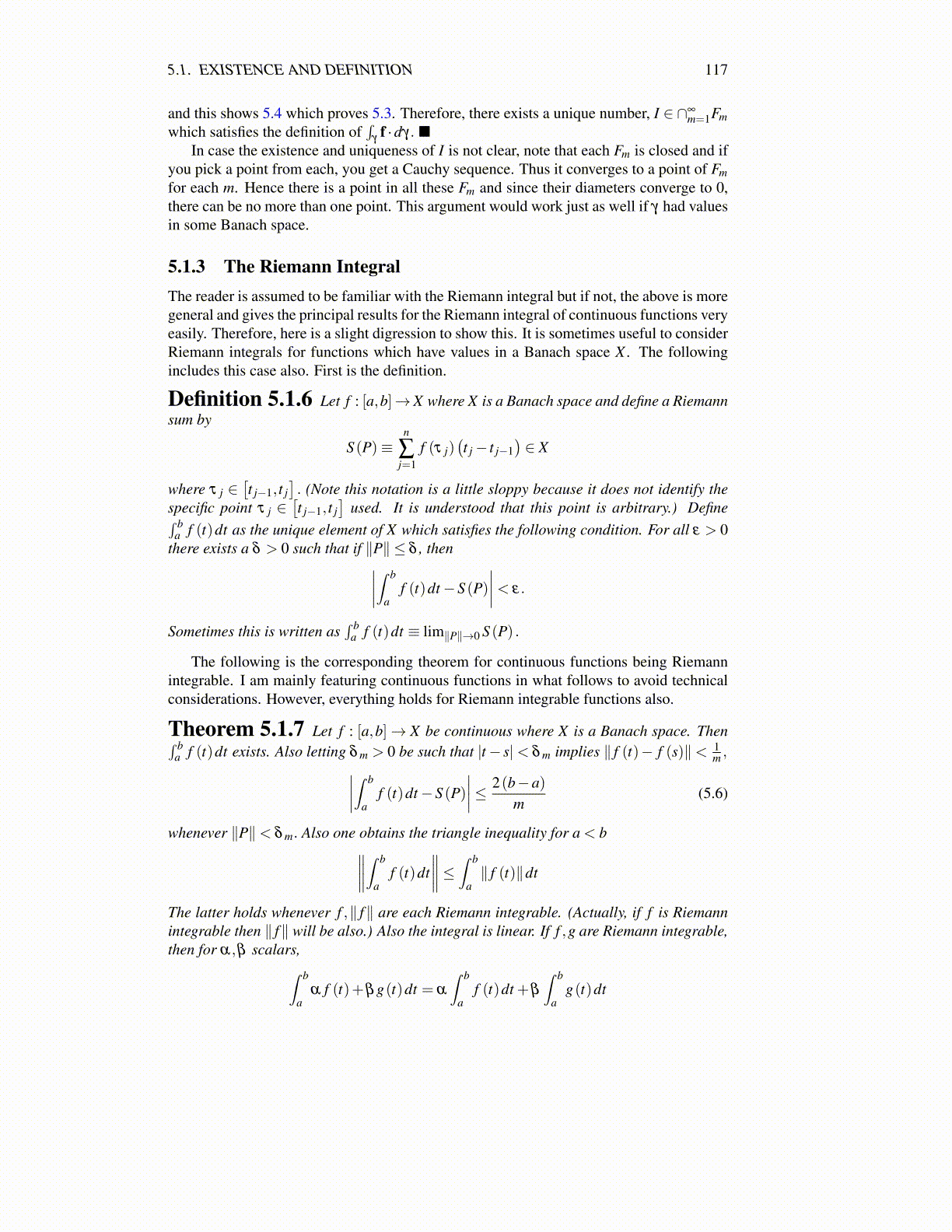
5.1. EXISTENCE AND DEFINITION 117
and this shows 5.4 which proves 5.3. Therefore, there exists a unique number, I ∈ ∩∞m=1Fm
which satisfies the definition of∫
γf ·dγ. ■
In case the existence and uniqueness of I is not clear, note that each Fm is closed and ifyou pick a point from each, you get a Cauchy sequence. Thus it converges to a point of Fmfor each m. Hence there is a point in all these Fm and since their diameters converge to 0,there can be no more than one point. This argument would work just as well if γ had valuesin some Banach space.
5.1.3 The Riemann IntegralThe reader is assumed to be familiar with the Riemann integral but if not, the above is moregeneral and gives the principal results for the Riemann integral of continuous functions veryeasily. Therefore, here is a slight digression to show this. It is sometimes useful to considerRiemann integrals for functions which have values in a Banach space X . The followingincludes this case also. First is the definition.
Definition 5.1.6 Let f : [a,b]→X where X is a Banach space and define a Riemannsum by
S (P)≡n
∑j=1
f (τ j)(t j− t j−1
)∈ X
where τ j ∈[t j−1, t j
]. (Note this notation is a little sloppy because it does not identify the
specific point τ j ∈[t j−1, t j
]used. It is understood that this point is arbitrary.) Define∫ b
a f (t)dt as the unique element of X which satisfies the following condition. For all ε > 0there exists a δ > 0 such that if ∥P∥ ≤ δ , then∣∣∣∣∫ b
af (t)dt−S (P)
∣∣∣∣< ε.
Sometimes this is written as∫ b
a f (t)dt ≡ lim∥P∥→0 S (P) .
The following is the corresponding theorem for continuous functions being Riemannintegrable. I am mainly featuring continuous functions in what follows to avoid technicalconsiderations. However, everything holds for Riemann integrable functions also.
Theorem 5.1.7 Let f : [a,b]→ X be continuous where X is a Banach space. Then∫ ba f (t)dt exists. Also letting δ m > 0 be such that |t− s|< δ m implies ∥ f (t)− f (s)∥< 1
m ,∣∣∣∣∫ b
af (t)dt−S (P)
∣∣∣∣≤ 2(b−a)m
(5.6)
whenever ∥P∥< δ m. Also one obtains the triangle inequality for a < b∥∥∥∥∫ b
af (t)dt
∥∥∥∥≤ ∫ b
a∥ f (t)∥dt
The latter holds whenever f ,∥ f∥ are each Riemann integrable. (Actually, if f is Riemannintegrable then ∥ f∥ will be also.) Also the integral is linear. If f ,g are Riemann integrable,then for α,β scalars,∫ b
aα f (t)+βg(t)dt = α
∫ b
af (t)dt +β
∫ b
ag(t)dt